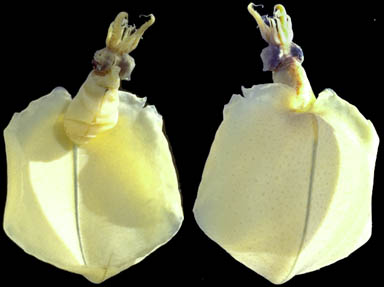Table of Contents
Magnapinna Pacifica, bigfin squid
This family was described from three individuals: Two juveniles about 50 mm ML and a paralarva of 19 mm ML. Virtually nothing is known about the biology of these squid; they have never been observed alive. The most distinctive features of these squid are very large terminal fins, short tentacles with numerous sucker series and arms and tentacles with slender, elongate tips that are vermiform in appearance.
photograph copyright © 1998, Richard E. Young
Other sightings of the 'elbowed' squid
Characteristics
From Vecchione and Young (1998):
- 1. Fins
- Length equal to or greater than squid length fromposterior tip of muscular mantle to tip of tentacles.
- Width approximates length.
- 2. Tentacles.
- Short, thick.
- Without keels or locking apparatus.
- Club suckers small, in approximately eight series except at base.
- Sucker dentition unknown.
- Distal tips vermiform.
- 3. Arms.
- Suckers biserial distally, in 3 to 4 series at base.
- Inner sucker rings probably smooth.
- Distal tips vermiform.
- 4. Photophores
- Absent
- 5. Funnel
- Locking apparatus with oval depression
Vecchione, M. and R. E. Young. 1998. The Magnapinnidae, a newly discovered family of oceanic squids (Cephalopoda; Oegopsida). South African Journal of Marine Science, 20: 429-437.)

